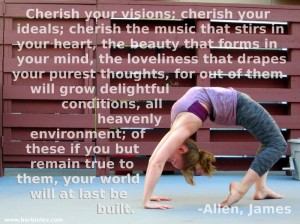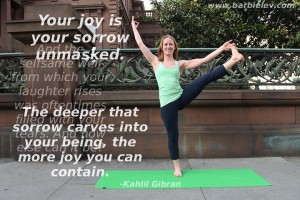
Cherish your visions; cherish your ideals; cherish the music that stirs in your heart, the beauty that forms in your mind, the loveliness that drapes your purest thoughts, for out of them will grow delightful conditions, all heavenly environment; of these if you but remain true to them your world will at last be built. – Allen, James
At the beginning of your yoga practice, cup your hands in front of your chest with palms facing upward. Imagine you’re holding a small pile of sand. The grains of sand you’re caressing represent your visions, your ideals, the music that stirs in your heart, the beauty that forms in your mind, and the loveliness that drapes your purest thoughts. Take a couple breaths to allow these individual grains to coalesce together to form an intention for your practice. It doesn’t have to be something that can be put into words. Exhale all the air from your lungs, and then inhale through the mouth, breathing in the contents of your hands so that your lungs, your body, and your soul are bathed in your intention.
At the end of your practice, take the same position with your hands and re-visualize the grains of sand that represent your visions, your ideals, the music that stirs in your heart, the beauty that forms in your mind, and the loveliness that drapes your purest thoughts. This time, allow the grains of sand to coalesce to form an intention for your practice off the mat, after class for the rest of your day or week. How can the benefits you were gifted on the mat allow you to be in more graceful, caring, and compassionate relationships with others? Take a full inhale through the nose, and then blow out through the mouth, visualizing your intention permeating beyond yourself, beyond the wall of the yoga room, and out into the world.






